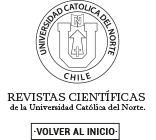Entre el tolar y el pajonal: percepción ambiental y uso de plantas en la comunidad atacameña de Talabre, II Región, Chile
DOI:
https://doi.org/10.22199/S07181043.1998.0016.00010Resumen
Se presentan los resultados de una investigación etnobotánica en la comunidad atacameña de Talabre, la que tuvo como objetivo caracterizar las percepciones y conocimientos que los habitantes de esta localidad poseen en relación a su medio entorno, y en especial respecto de los recursos florísticos silvestres comprendidos en su territorio. La metodología empleada combinó técnicas de investigación provenientes de la botánica y etnografía y se caracterizó por excursiones de colecta, confección de herbario, observación participante y entrevistas en profundidad. En el área de estudio se colectaron un total de 70 especies, provenientes de zonas vegetacionales tanto zonales como azonales. Los habitantes de esta localidad identifican como principales unidades ecológicas el Tolar y el Pajonal, pisos en donde se ubican diferentes tipos de especies florísticas, y en donde desarrollan sus principales actividades económicas de subsistencia. También fue posible distinguir e identificar los principales rubros de utilización de tales recursos, destacando los empleados en las actividades medicinales y de forrajeo, actividades articuladas por un antiquísimo sistema de medicina tradicional, aún vigente en el área de estudio, y por una estrategia de subsistencia –el pastoreo de tipo estacional– que ha acompañado al habitante de esta zona desde los orígenes de la interacción con el medio ambiente circundante.
ABSTRACT
The ethnographic studies accomplished recently in the different human establishments of the Puna de Atacama has demonstrated the tremendous knowledge that the Andean man of this zone posses about his environment, and in particular of the floristic resources, wild as well as domesticated. The Atacamenian community of Talabre does not escape from the situation mentioned before, and this made it possible to accomplish exploring studies of the ethnobotanic of this zone with the purpose of characterizing the perceptions and knowledges that the residents of this town possess about their environment, especially of the vegetational resources of their territory. The methodology employed used technics from the botanic and ethnography and was characterized by excursions to collect, confectioning herbs, participating observation and exhausting interviews. In the area of study there were collected a total of 70 species, proceeding from the vegetational zone in the territory as well as outside it. The residents of this area identifies the Tolar and the Pajonal as the main ecological unities, belts where different kind of floristic species are located, and where they develope their main economic activities to subsistence. It was also possible to distinguish and identify the main items that uses such resources, emphasizing the ones used in the medicinal activities and foraging, activities articulated by a very antique system of tradicional medicine still in force in the area, and by a strategy of subsistence –the season sheperding– which has followed the residents of this zone since the origin of the interaction with the surrounding environment.
Descargas
Descargas
Publicado
Número
Sección
Licencia
Todos los trabajos publicados en Revista Estudios Atacameños (eISSN:0718-1043) están sujetos a una licencia Creative Commons Reconocimiento 4.0 Internacional
Los autores continúan como propietarios de sus trabajos, y pueden volver a publicar sus artículos en otro medio sin tener que solicitar autorización, siempre y cuando indiquen que el trabajo fue publicado originariamente en Revista Estudios Atacameños (eISSN:0718-1043).












